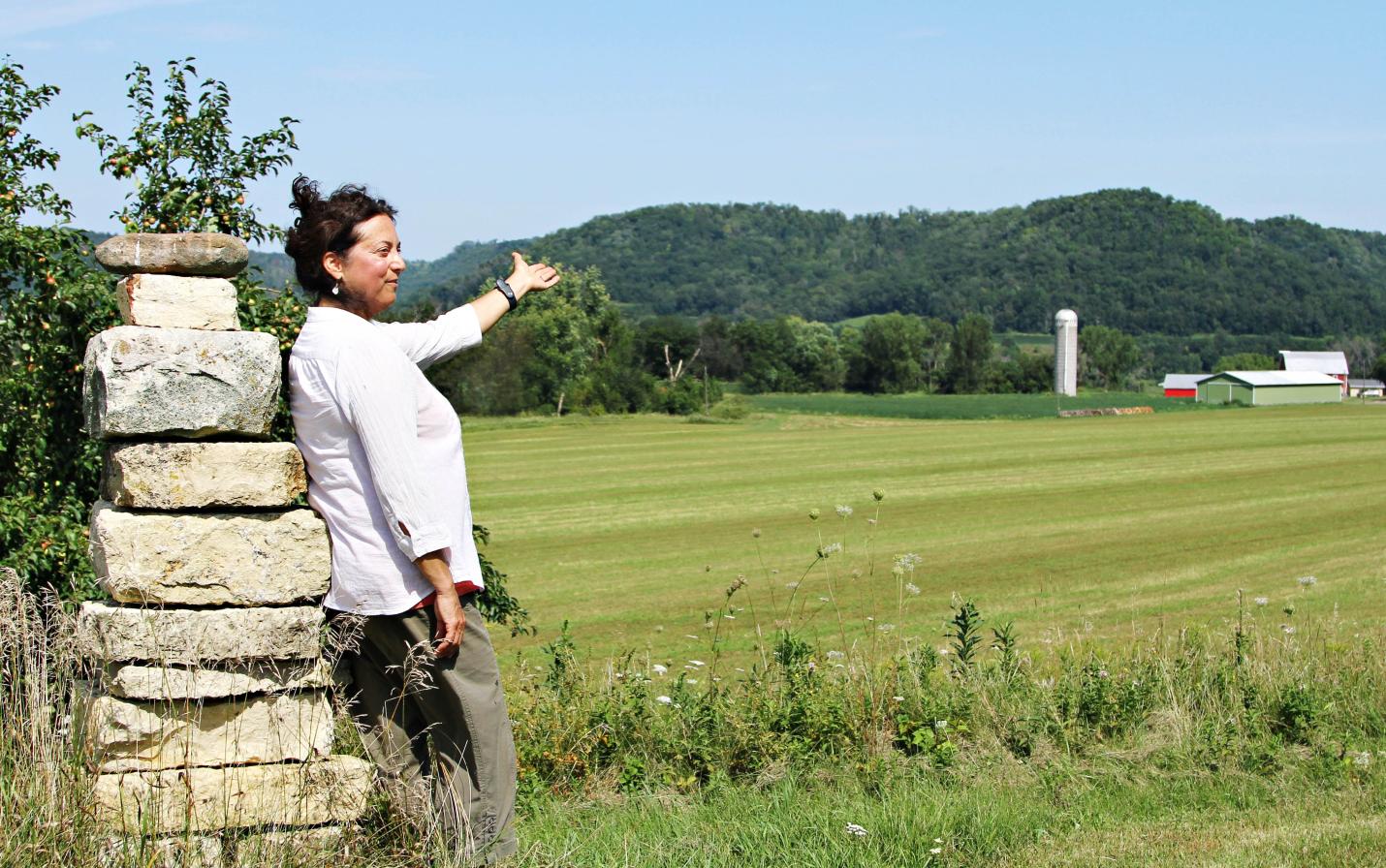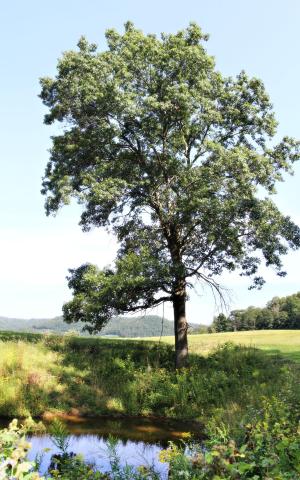
Land Conservator Nurses Buffalo River Watershed Farmland Back to Health
LA CROSSE, WI – Aimee Ebersold Schultz knows a lot about the patience and hard work of healing. In 2010, she began her stewardship of an old farmhouse and 114 acres near Alma, Wisconsin, where she learned about sustainable farming practices including managed rotational grazing, soil health, and writing and negotiating farm leases. Now, after a 24-year nursing career and the loss of a spouse, she is newly remarried and devoting her energy to caring for the land. Aimee has developed relationships with the farmers who farm the fields while listening to and observing the needs of the environment. Her conscientious care has continued through creating pollinator habitat, managing woodlands, preventing soil erosion, and, most recently, protecting the long-term health of the property with a conservation easement through Mississippi Valley Conservancy. But as Aimee is quick to point out, her relationship with the land is reciprocal. She works to heal the soil and habitat of her property by planting native flower seeds and maintaining soil erosion ponds. In return she gets to witness the growing numbers of grassland birds and leopard frogs, as well as hear the vibrant hum of thriving insects. She acknowledges, “All of this heals me too.”
Aimee finds these interconnections inspiring stating, “It helps me with perspective for everything that happens in my life.” She marvels at how even a small patch of long grass behind the barn can become its own web of living relationships: apple trees and clovers offer food and protective cover for mice, deer and rabbits, while hawks and even a great horned owl sometimes benefit from these comings and goings, too. Behind the alfalfa fields, a pair of honking sandhill cranes rises into the air. “It’s inspiring, deeply satisfying, and so full of life,” says Aimee.
On an even larger scale, as Aimee continues to restore the health of her own property, she is also improving and protecting the ecological balance of the watershed as a whole. This includes the Buffalo River and the adjacent Upper Mississippi River National Wildlife and Fish Refuge. Aimee comments, “this is no different than practicing holistic nursing, that has healing a ‘whole person’ as its goal.” Dennis Reimers, a conservationist from the Natural Resources Conservation Service who has been advising Aimee on her conservation planning, underscores the importance of the erosion control ponds that have been created on her farm. “This farm is located on the first terrace above the Buffalo River. This landscape position typically has some of most erosive soil types in the county.” Yet Aimee is turning that around; her ponds trap sediment and pollution from rain run-off that would otherwise leach to nearby streams and the Buffalo River wetlands area, just 100 feet away. Her property also sutures the gap in wildlife byways: “There are over 20 listed species of special concern, threatened, or endangered adjacent to this site,” Reimers notes. State listed species include bobolinks nesting in the pollinator prairies and hayfields, and little brown bats roosting in Aimee’s historic barn.

Achieving a sustainable future for Aimee’s land will still take time and she understands the recovery milestones ahead. “Just as in life” she says, “moving towards a sustainable future for this land will be a work in progress.” Her plans include support from Farm Bill programs for further integrating pollinator plantings with farmland, removing farmland from production to create more balance for wildlife habitat, as well as starting conservation practices for woodland areas, according to her newly developed forest management plan. “Farming for the land, wildlife, supporting people who rely on a farming way of life, and the communities that small family farms create. I view conservation as integrated work,” Aimee says.
Just as Aimee is weighing the needs of community in her decisions about stewarding the land, building a sense of community with others supports her health and makes her dreams a reality. A source of joy over the last two years she says has been hosting a 5th grade school group on the farm. “We gather in the old barn and talk about conservation. Then the kids can run around and pick apples from the trees! This land truly holds us all.” She quotes a saying she finds useful: “Want to go fast, go alone; want to go farther, go together.” Aimee lives this idea not only through her membership with the Conservancy, but also by working with Wisconsin Women in Conservation, the Land Stewardship Project, and relying on numerous informational resources. On a more personal level, she shares, “spiritual teachers have guided me step by step along the path, friends are an important source of inspiration and support, and my husband Tom has been instrumental in making all these conservation projects happen. His 37 years of working in land conservation for this county brings his life’s work to this farm, and in turn, has brought this farm to life.”
“Caring for the land is nursing on the largest scale” Aimee says. “It is intergenerational work, and it is soul work. Life brings questions and uncertainties. Land allows you to hold that and express it, fostering creativity and imagination.” These non-linear, reciprocal ties of ecology and healing also extend to her own family history. Aimee is a lineal descendant of the Mdewakanton and Wahpakute Bands of Dakota. She is gratified that her ethic of caretaking stretches back to earlier generations of mixed Dakota, French, and Swiss German ancestors, knowing that the land she now owns and conserves used to belong to the Dakota, and that one of her indigenous grandmothers witnessed the will that eventually transferred the property to Aimee. Through the Conservancy’s easement, Aimee has ensured that her land and its inhabitants will be protected from future subdivision and development that could disrupt all she has done to restore its health. The conservation easement was signed on Aimee’s birthday, something she finds worthy of celebrating: “A conservation easement will be a most meaningful birthday gift in honor of life—this interconnected web of life,” she says.
Top photo: Aimee Ebersold Schultz showing her conserved land which has diverse native wildlife habitats and working farmland. The land is now protected with a conservation easement.